Weathervanes – for Collectors and Those Passionate About Seeing Which Way the Wind Blows
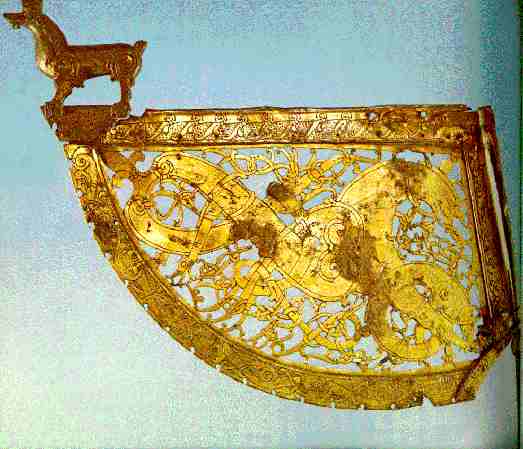 Weathervanes are mentioned in the ancient writings of Mesopotamia, from over 3500 years ago. The Chinese also talk about strings or flags being used to read wind direction in writings dated to the 2nd Century B.C. Vikings are also credited with using a form of weathervane to predict the weather in the 9th century A.D.
Weathervanes are mentioned in the ancient writings of Mesopotamia, from over 3500 years ago. The Chinese also talk about strings or flags being used to read wind direction in writings dated to the 2nd Century B.C. Vikings are also credited with using a form of weathervane to predict the weather in the 9th century A.D.
Their designs were made of bronze and other metals and replaced traditional cloth flags on Viking ships. They were frequently quadrant-shaped and depicted an animal or creature from Norse myth. These weathervanes can still be seen today in Sweden and Norway.
Many of these classic style weathervanes from the last century are being sold as pricey antiques. These historic weathervanes have been sold for anywhere between $50,000 to more than $750,000.
This week we offer a way to make your own version in DIY Hints – a project that all age groups can get involved in and create something unique and beautiful at the same time – a great afternoon’s fun if we have a few wet days coming up during the April School Holidays. To further inspire you, we offer a few insights into the quite ancient and still modern way to tell which way the wind blows…
The word 'vane' comes from the Old English word fane meaning 'flag' or ‘banner’. Bird motifs are the oldest known design used as wind vane pointers. A Sumerian vane was described as a bird in 2000 B. C. and then we have the Chinese bird of 101 B.C.. It’s not known if the “bird’ in each case was a rooster but it is quite possible due to the importance of roosters in each culture. It would further the fact that roosters have been the most popular motif throughout history.
The first mention of a rooftop rooster figure is from the mausoleum of the Flavier in North African Cilium about 200 A. D.. The oldest Rooster vane in existence is the cock of Brescia, Italy from 820 A. D.. It is believed that around this time, the pope decreed each catholic church would bear a cock as a reminder of Peter on the Cavalry: “In this night, before the rooster crows, you will deny me three times” (Matthew 26, 34). English writer Albert Needham was the first to write this claim, but evidence of the Papal decree has never been found.
The motifs of these symbols atop buildings has changed through the centuries they have been used with whales or ships in areas close to sea while animals found on the farm are used in rural areas.
WEATHER VANES. The weather vane, in one form or another, is so venerable that its actual origin is lost in the dim twilight of ages for remote. One of the earliest weather vanes of which history bears definite witness was the famous 'Tower of the Winds,' built in Athens shortly before the dawn of the Christian era. The tower was octagonal in form, symbolical, doubtless, of the eight principal winds, and upon its summit stood a bronze figure pointing in the direction' from which the wind proceeded. During later days the thoughtful designing of vanes received considerable attention, and, particularly in England, they assumed a highly decorative appearance at the hands of the trade guilds or where they appeared upon churches. WEATHER VANES. (1915, February 11). Freeman's Journal(Sydney, NSW : 1850 - 1932), p. 42. Retrieved from http://nla.gov.au/nla.news-article115307623
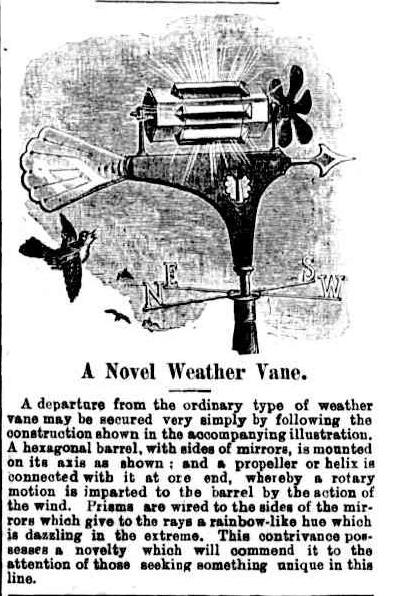 A Novel Weather Vane. A departure from the ordinary type of weathervane may be secured very simply by following the construction shown in the accompanying illustration. A hexagonal barrel, with sides of mirrors, is mounted on its axis as shown; and a propeller or helix is connected with it at one end, whereby a rotary motion is imparted to the barrel by the action of the wind. Prisms are wired to the sides of the mirrors which give to the rays a rainbow-like hue which is dazzling in the extreme. This contrivance possesses a novelty which will commend it to the attention of those seeking something unique in this line. A Novel Weather Vane. (1887, September 3). Australian Town and Country Journal (NSW : 1870 - 1907), p. 25. Retrieved from http://nla.gov.au/nla.news-article71088730
A Novel Weather Vane. A departure from the ordinary type of weathervane may be secured very simply by following the construction shown in the accompanying illustration. A hexagonal barrel, with sides of mirrors, is mounted on its axis as shown; and a propeller or helix is connected with it at one end, whereby a rotary motion is imparted to the barrel by the action of the wind. Prisms are wired to the sides of the mirrors which give to the rays a rainbow-like hue which is dazzling in the extreme. This contrivance possesses a novelty which will commend it to the attention of those seeking something unique in this line. A Novel Weather Vane. (1887, September 3). Australian Town and Country Journal (NSW : 1870 - 1907), p. 25. Retrieved from http://nla.gov.au/nla.news-article71088730
A NEW WEATHER VANE. One can measure at any time the force of wind by means of the instrument known as the anemometer, but in this way it is impossible to obtain any vivid idea of the wind's velocity. The anemometer will tell accurately whether a wind is travelling at the rate of 20 or 30 miles an hour, but It cannot make visible the difference between a moderate and a strong wind.
A German inventor has now devised a scheme by which the force of the wind can be clearly observed. The principal parts of this new invention are an anemometer and a vane. These two parts are connected in such a manner that the force of the wind is measured on the anemometer, while at the came time the rate at which it is going can be observed by the motions of the vane, and of a revolving plate which is attached to it.
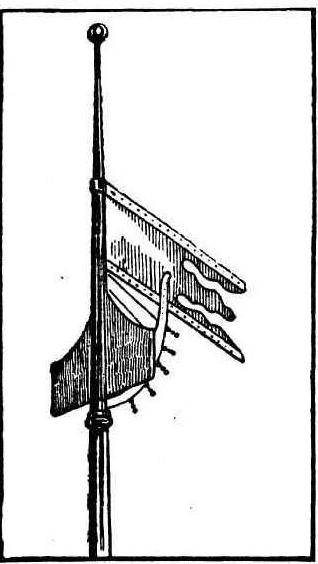 Moreover, for both purposes a scale is used, which shows whether a wind, blowing at anytime, is light, moderate, strong, stormy, a gale, or a hurricane. Those who have seen this device say that it does excellent work, and would prove extremely useful on schoolhouses, and at race tracks and seaside resorts. A NEW WEATHER VANE. (1902, October 11). The World's News (Sydney, NSW : 1901 - 1955), p. 14. Retrieved from http://nla.gov.au/nla.news-article128453608
Moreover, for both purposes a scale is used, which shows whether a wind, blowing at anytime, is light, moderate, strong, stormy, a gale, or a hurricane. Those who have seen this device say that it does excellent work, and would prove extremely useful on schoolhouses, and at race tracks and seaside resorts. A NEW WEATHER VANE. (1902, October 11). The World's News (Sydney, NSW : 1901 - 1955), p. 14. Retrieved from http://nla.gov.au/nla.news-article128453608
A weather vane (or weathercock) is an instrument for showing the direction of the wind. They are typically used as an architectural ornament to the highest point of a building. Although partly functional, weather vanes are generally decorative, often featuring the traditional cockerel design with letters indicating the points of the compass. Other common motifs include ships, arrows and horses. Not all weather vanes have pointers.
The design of a weather vane is such that the center of gravity is directly over the pivotal axis, so that the pointer can move freely on its axis, but the surface area is unequally divided. The side with the larger surface area is blown away from the wind direction, so that the smaller side, with the pointer, is pivoted to face into the wind direction. For example, in a 'Nor-Easter' (a wind that blows from the north-east), the pointer will point toward the north-east. Most weather vanes have directional markers beneath the arrow, aligned with the geographic directions.
To obtain an accurate reading, the weather vane must be located well above the ground and away from buildings, trees, and other objects which interfere with the true wind direction. Changing wind direction can be meaningful when coordinated with other apparent sky conditions, enabling the user to make simple short range forecasts. From the street level the size of many weathercocks is deceptive.
History
The Tower of the Winds on the ancient Roman agora in Athens once bore on its roof a wind vane in the form of a bronze Triton holding a rod in his outstretched hand, rotating as the wind changed direction. Below, the frieze was adorned with the eight wind deities. The eight metre high structure also featured sundials, and a water clock inside dates from around 50 BC.
Pope Gregory I said that the cock (rooster) "was the most suitable emblem of Christianity", being "the emblem of St Peter". Some say that it was as a result of this that the cock began gradually to be used as a weather vane on church steeples, and some add that in the 9th century Pope Nicholas I ordered the figure to be placed on every church steeple. and it is known that Pope Leo IV did have it placed on the Old St. Peter's Basilica or old Constantinian basilica even before Nicholas I was Pope. Alternative theories about the origin of weathercocks on church steeples are that it was an emblem of the vigilance of the clergy calling the people to prayer, that it was derived from the Goths and is only possibly a Christian symbol, and that it is an emblem of the sun.
As it were, Pope Nicholas I did in fact decree in the 9th century that all churches must show the symbol of a cock on its dome or steeple, as a symbol of Jesus' prophecy of Peter's betrayal (Luke 22:34), that Peter would deny him three times before the rooster crowed on the morning following theLast Supper. Many churches started using this symbol on its weathervanes. In the Bayeux Tapestry of the 1070s, originally of the Bayeux Cathedral (Cathédrale Notre-Dame de Bayeux) and now exhibited at Musée de la Tapisserie de Bayeux in Bayeux, Normandy, there is a depiction of a man installing a cock on Westminster Abbey. Other sources cited above say the custom had begun more than two centuries earlier. In fact, the oldest weather vane with the shape of a rooster existing at the world is the Gallo di Ramperto, made in the 820 and now preserved in the Museo di Santa Giulia in Brescia, Lombardy.
Early weather vanes had very ornamental pointers, but modern weather vanes are usually simple arrows that dispense with the directionals because the instrument is connected to a remote reading station. An early example of this was installed in the Royal Navy's Admiralty building in London - the vane on the roof was mechanically linked to a large dial in the boardroom so senior officers were always aware of the wind direction when they met.
Modern aerovanes combine the directional vane with an anemometer (a device for measuring wind speed). Co-locating both instruments allows them to use the same axis (a vertical rod) and provides a coordinated readout.
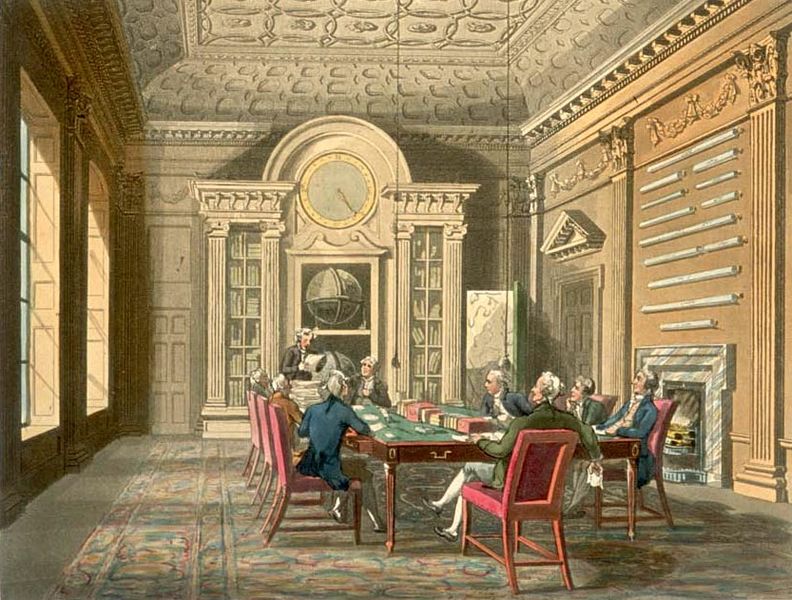
The Board of Admiralty: This engraving was published as Plate 3 of Microcosm of London (1808) (see File:Microcosm of London Plate 003 - Board Room of the Admiralty.jpg). Date 1808
Weather vane. (2013, November 24). In Wikipedia, The Free Encyclopedia. Retrieved from http://en.wikipedia.org/w/index.php?title=Weather_vane&oldid=583110949
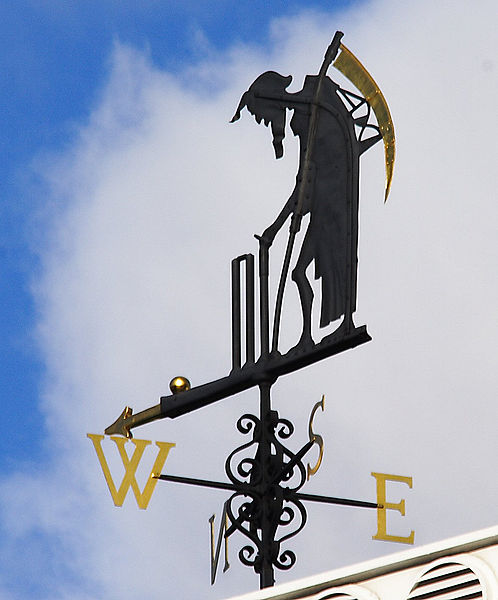 Old Father Time is a weather vane at Lord's Cricket Ground, London, in the shape of Father Time removing the bails from a wicket. The weathervane is a total of 6 ft 6 in (1.98 m) tall, with the figure of Father Time standing at 5 ft 4 in (1.63 m). It was given to Lord's in 1926 by the architect of the Grandstand, Sir Herbert Baker.
Old Father Time is a weather vane at Lord's Cricket Ground, London, in the shape of Father Time removing the bails from a wicket. The weathervane is a total of 6 ft 6 in (1.98 m) tall, with the figure of Father Time standing at 5 ft 4 in (1.63 m). It was given to Lord's in 1926 by the architect of the Grandstand, Sir Herbert Baker.
The symbolism of the figure derives from Law 16(3) of the Laws of Cricket: "After the call of Time, the bails shall be removed from both wickets."
Old Father Time was originally located atop the old Grand Stand. It was wrenched from its perch during the Blitz, when it became entangled in the steel cable of a barrage balloon, but was repaired and returned to its previous position. In 1992 the weather vane was struck by lightning, and the subsequent repairs were featured on children's television programme Blue Peter. Old Father Time was permanently relocated to the Mound Stand in 1996, when the Grand Stand was demolished and rebuilt.
In 1969 Old Father Time became the subject of a poem, "Lord's Test", by the Sussex and England cricketer John Snow.
Right: Old Father Time, the famous weathervane at Lord's. Source: Flick (User:hamilcar_south)
Later, spiritlike,.
while Father Time above the northern stand.
eyes the breeze,.
you move aside.
and see a body flailing,.
bowl a ball swinging.
along its way, batsman playing.
from Lord's Test, by John Snow
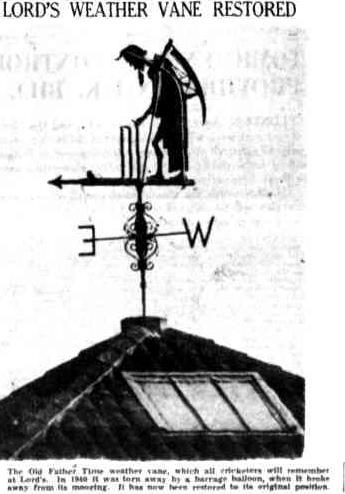 The Old Father Time weather vane, which all cricketers will remember at Lord's. In 1940 it was torn away by a barrage balloon, when it broke away from Its mooring:. It has now been restored the original position. LORD'S WEATHER VANE RESTORED. (1946, April 29).Townsville Daily Bulletin (Qld. : 1885 - 1954), p. 1. Retrieved from http://nla.gov.au/nla.news-article62880435
The Old Father Time weather vane, which all cricketers will remember at Lord's. In 1940 it was torn away by a barrage balloon, when it broke away from Its mooring:. It has now been restored the original position. LORD'S WEATHER VANE RESTORED. (1946, April 29).Townsville Daily Bulletin (Qld. : 1885 - 1954), p. 1. Retrieved from http://nla.gov.au/nla.news-article62880435
REVIVING THE WEATHERVANE. There are signs of a revival In the use of weather vanes-which all lovers of the picturesque and old world will welcome. A vane is not a difficult thing to design to anyone who has the gift of drawing and the perseverance to carry out their ideas. Once the outline of the silhouette Is decided upon it is easy to have it cut out by a blacksmith, or you may find a piece of copper and cut out the design yourself, and so make the vane for a cost of some 10s. In composing the design it is of course necessary to keep in mind that the sail area on one aide must exceed that on the other to insure that the vane will turn with the wind. Then, to set up the vane in a simple way, an Iron rod Is attached to it, and the rod is dropped into a tube-a length of gas pipe serves the purpose. The iron rod should be pointed at the end, and at the bottom of the tube there should be a marble, or a pebble on which the point may revolve. A modern weather-vane costs from five to 10 pounds, according to the beauty of the design and the fineness of the workmanship. An elaborate design suds as the ship at Rochester, beaten in copper, would cost from £100 to £150. Even if expensive, it is an ornament well worth its price-considering the air, the distinction, the brilliant finishing touch it gives to a building. The most famous London vanes are the dragon on St. Mary-le-Bow and the grasshopper on the Corn Exchange, measuring eleven feet over all. The story goes that when this dragon and this grasshopper ultimately meet together in the same builder's yard the streets of London will run red with blood-an unpleasant notion. "Pearson's Magazine." REVIVING THE WEATHER VANE. (1904, January 18).Examiner (Launceston, Tas. : 1900 - 1954), p. 3 Edition: DAILY.. Retrieved from http://nla.gov.au/nla.news-article35788055
On a last note, 'like a weather-vane’ has been ascribed to anyone of changing opinions to suit prevailing environment – this has been applied to politicians. To those who change fashions as frequently as fashion itself changes, and to a person who changes their opinion to suit the ‘way the wind is blowing’ adds a bit of culturally significant phraseology to our thousands of years use of weathervanes:
SIDNEY KIDMAN CRITICISED " WEATHER-VANE " PECULIARITIES. T. G. ELLEBY'S REBUTTAL.
The evidence of Mr. Sidney Kidman, given before the Abattoirs Commission on August 14. was the subject of some comment in a long statement tendered by Mr. T. G. Ellery (general manager of the Metropolitan Abattoirs) in rebuttal of assertions made before the commission.
Mr. Kidman, continuing his evidence, said he had seen cattle-yards all over the world, and that he did not think any yards had 'been so badly erected as those at the abattoirs, and that the facilities in Queensland were the best in Australia'. Mr. Kidman was like a weather vane—he blew in one direction today and in another direction to-morrow, because—in a letter to the Melbourne "Age," dated September 24, 1912, in criticising the facilities for handling and selling of cattle is the -various States, Mr. Kidman 6aid:—"I did not say the system of selling cattle in Sydney was the worst. I said the system of Tailing the cattle from Brisbane to Sydney was the worst. I consider the Sydney cattleyards compare very well with any in Australia, and it is on a par with Melbourne. Brisbane is the worst. Of course, as soon as the Adelaide abattoirs and yards are completed it will be more up to date than any of them." SIDNEY KIDMAN CRITICISED. (1914, September 17). Daily Herald (Adelaide, SA : 1910 - 1924), p. 4. Retrieved from http://nla.gov.au/nla.news-article105642294
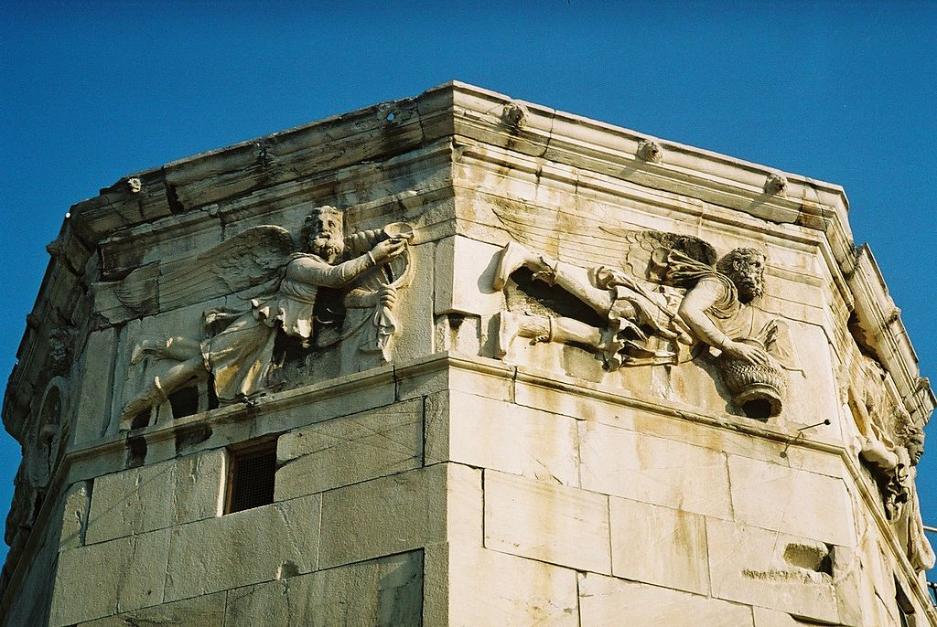
Detail of the frieze on the Tower of the Winds. Shown are the Greek wind gods Boreas (north wind, on the left) and Skiron(northwesterly wind, on the right). Photo By and courtesy of M Doege, 2003.
Extras:
WEATHER VANE GAME FOR CHILDREN
In this game one child is chosen for the Weather Man. The other players, representing weather vanes, stand with outstretched arms. 'South!' calls the Weather Man, and all the weather vanes turn so that the right hand 'points to the south, The left arm is tho fan and whirls around and around. All the directions are given in this way. When the Weather Man shouts, 'A big storm is coming! Whirlwind!' each player whirls 'around on one heel as fast as he can. WEATHER VANE. (1933, August 18). Albury Banner and Wodonga Express (NSW : 1896 - 1938), p. 21. Retrieved from http://nla.gov.au/nla.news-article102267920
An apparent wind indicator, as found on sailboat, is a small weather vane or arrow that gives an indication of the current apparent wind direction. This indication allows the skipper to set their sails or their course for best performance, according to the points of sail. The device is often referred to as a Windex.
Weather-Vane Legend.
The city of London has some peculiar weather-vanes on the spires of some of its churches The most curious of all are the grasshopper vane on the Royal Exchange and the dragon on the lofty steeple of Bow Church in Cheapside. The golden grass-hopper was the crest of Sir Thomas Gresham, the great merchant of Queen Elizabeth's reign. He it was who built the first Royal Exchange, and so it was quite appropriate that the tower of the present building should still display his device. A legend prophesied disaster to the city of London when the grasshopper of the Royal Exchange and the dragon of Bow Church should meet. This seemed to be so unlikely ever to happen that it was regarded as an exceptionally quaint kind of joke-as much as it would be if we were to imagine the Monument in the city side by side with the Albert Memorial in Kensington Gardens. But the meeting took place some 50 years ago, when the dragon and the grasshopper were taken down at the same time, to be regilded, and reposed side by side in the same yard, but nothing happened. Weather-Vane Legend. (1917, January 26). The Advertiser(Adelaide, SA : 1889 - 1931), p. 8. Retrieved fromhttp://nla.gov.au/nla.news-article5556621
St Mary-le-Bow is a historic church in the City of London on the main east-west thoroughfare, Cheapside. According to tradition a true Cockney must be born within earshot of the sound of Bow Bells (which refers to this church's bells rather than St Mary and Holy Trinity, Bow Road, in Bow, which until the 19th century was an outlying village). Archaeological evidence indicates that a church existed on this site in Saxon period England. A medieval version of the church had been destroyed in the late 11th century by one of the earliest recorded (and one of the most violent) tornadoes in Britain, the London Tornado of 1091. During the later Norman period, the church known as “St Mary de Arcubus” was rebuilt and was famed for its two arches (“bows”) of stone. From at least the 13th century, the church was a peculier of the Diocese of Canterbury and the seat of the Court of Arches, to which it gave the name. The church with its steeple had been a landmark of London and the “bow bells”, which could be heard as far away as Hackney Marshes, were once used to order a curfew in the City of London. This building burned in the Great Fire of London of 1666.
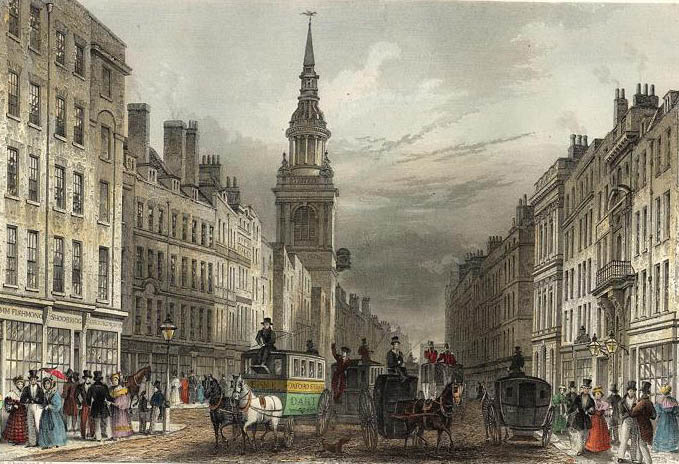
Cheapside and Bow Church in London. Engraved by W.Albutt after T.H.Shepherd, published 1837.
Considered the second most important church in the City of London after St Paul's Cathedral, St-Mary-le-Bow was one of the first churches to be rebuilt by Christopher Wren and his office for this reason. The current building was built to the designs of Wren 1671—1673; the 223 feet (68 m) steeple was completed 1680. The mason-contractor was Thomas Cartwright, one of the leading London mason-contractors and carvers of his generation.
In 1914, a stone from the crypt of St Mary-le-Bow church was placed in Trinity Church, New York in commemoration of the fact that King William III granted the vestry of Trinity Church the same privileges as St Mary-le-Bow vestry which was the forenunner to lower-tier local government. A recording of the Bow Bells made in 1926 has been used by the BBC World Service as an interval signal for the English-language broadcasts since the early 1940s. It is still used today preceding some English language broadcasts.
Much of the current building was destroyed by a German bomb during the Blitz on 10 May 1941, during which fire the bells crashed to the ground. Restoration under the direction of Laurence King was begun in 1956 (with internal fittings made by Faith-Craft, part of the Society of the Faith) and the bells as listed above, cast in 1956, were eventually installed to resume ringing in 1961. The church was formally reconsecrated in 1964 having achieved designation as a Grade I listed building on 4 January 1950. St Mary-le-Bow. (2013, July 31). In Wikipedia, The Free Encyclopedia. Retrieved from http://en.wikipedia.org/w/index.php?title=St_Mary-le-Bow&oldid=566524440
,%20Saturday%201%20October%201927,%20page%2010.jpg?timestamp=1395807732279) Repairs to Weather Vane
Repairs to Weather Vane
Mr. Larkin, popularly known as "Sky" Larkin, is a well-known steeplejack of London. He is here seen effecting repairs to the bronze model, serving as a weather vane, which has been the proud possession of the Sailors' Church, Dock Street, London E., for eighty years. Repairs to Weather Vane. (1927, October 1). The World's News(Sydney, NSW : 1901 - 1955), p. 10. Retrieved from http://nla.gov.au/nla.news-article130605233
STILL "SAILING."
 According to legend, London will not starve so long as this model ship, which serves as a weather vane on the spire of St. Michael's Church, Queenhithe, "keeps sailing." The copper ship has been in full sail for 269 years. Christopher Wren, the great ecclesiastical architect, had it put on the spire in 1677. STILL "SAILING.". (1946, August 15). The West Australian(Perth, WA : 1879 - 1954), p. 11. Retrieved fromhttp://nla.gov.au/nla.news-article46163830
According to legend, London will not starve so long as this model ship, which serves as a weather vane on the spire of St. Michael's Church, Queenhithe, "keeps sailing." The copper ship has been in full sail for 269 years. Christopher Wren, the great ecclesiastical architect, had it put on the spire in 1677. STILL "SAILING.". (1946, August 15). The West Australian(Perth, WA : 1879 - 1954), p. 11. Retrieved fromhttp://nla.gov.au/nla.news-article46163830
This weather vane was moved to St. Nicholas Cole Abbey a church in the City of London located on what is now Queen Victoria Street. Recorded from the twelfth century, the church was destroyed in the Great Fire of London in 1666 and rebuilt by the office of Sir Christopher Wren. The church suffered substantial bomb damage from German bombs during the London Blitz in the Second World War and was reconstructed by Arthur Bailey in 1961-2. The church is named after the 4th century St Nicholas of Myra. “Cole Abbey” is derived from “coldharbour”, a medieval word for a traveller’s shelter or shelter from the cold. The earliest reference to the church is in a letter of Pope Lucius II in 1144-5. St Nicholas of Myra is patron saint of, among other groups, children and fishermen, and the church has special ties with both.
The spire has two rows of lunettes and a small balcony near the top, resembling a crow's nest. At the very top is a vane in the shape of a three-masted barque in the round. This came from St Michael Queenhithe(demolished 1876) and was added to the spire in 1962. Some sources state the pre-War vane was in the shape of a pennant with 4 S shapes back to back. The current vane is in the shape of a three-masted barque, of the type used to carry corn – a reference to the chief cargo unloaded at the nearby dock. Just underneath the ship was a brass sphere that could hold a bushel of grain.
After the church was demolished, the vane remained in situ perched on a miniature spire. It was moved to the top of the newly restored spire of St. Nicholas Cole Abbey in 1962, where it remains today.. St Nicholas Cole Abbey. (2013, September 27). In Wikipedia, The Free Encyclopedia. Retrieved from http://en.wikipedia.org/w/index.php?title=St_Nicholas_Cole_Abbey&oldid=574735358
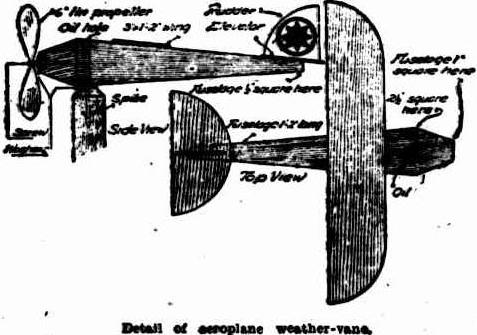 An Aeroplane Weather Vane.
An Aeroplane Weather Vane.
WEATHER vanes are made in all sorts of forms—ships, arrows, cows, birds, or anything that the maker's fancy suggests. An aeroplane is an up-to-date model for a vane. Unlike other model aeroplanes, this one always keeps its nose to the wind, and the propeller turns with every breeze; so you can always tell the direction of the wind by watching to see which way the 'plane heads. The parts are shown m the accompanying diagrams for which we are indebted to "The Country Gentleman". Get a piece of light wood, fourteen inches long and two and a half inches square, and from this cut the fuselage to the dimensions shown. Bore a half-inch hole a half inch deep in the nose. Bore another hole down through the body two and a half inches behind the nose, this hole to be very little larger than a NO. 9 nail. Cut the wings from thin pine (three ply-will do), three inches wide and fourteen Inches long, and round the front corners. Then fasten this to the fuselage with a couple of small brads and glue. Cut out the elevator and rudder pieces from still thinner wood, and glue the elevator in place, using a few brads also. When the glue has dried, make a saw cut two inches deep in the tail, and glue in the rudder piece as shown. This rudder must he lame enough always to bring the propeller into the wind when it is in use. Get a stick of wood say two inches square, and into the top drive a long No. 9 nail with the head filed off. A straight piece of fencing wire (say No. 8) will do instead of a nail, but the hole in the 'plane must be enlarged to suit. Then put a washer over the spike, and pack some oil-soaked cotton into the top of the hole. Cutout a six-inch propeller from light tin, bend to shape, and fasten this with a screw to the nose, with a washer or two between the prop and nose. Fill the hollow hole with cotton, and oil this too. Now give the ship three coats of paint in two or three colours. This weather vane will make a fine addition to the garage, barn, or shed roof. The dimensions may vary somewhat to suit materials you may have on hand. An Aeroplane Weather Vane. (1931, January 15).The Queenslander (Brisbane, Qld. : 1866 - 1939), p. 52. Retrieved from http://nla.gov.au/nla.news-article23134049
BIRD OF ILL-OMEN. CROMER'S DOOMED WEATHER VANE.
In deference to ancient superstition, the council at Cromer, Norfolk, has decided to take down a weather vane with the figure of a crow as a wind direction finder, which it had erected. Fishermen have protested that the crow is a bird of ill-omen, and that since its image was set up their catches of crabs and lobsters have fallen off. Lands-men, too, have urged the council to remove the vane, saying that the crow is a symbol of "death, disaster and destruction."
The chairman of the council (Mr. A.E. Williams) has promised to give a new vane with some other device. This will bring much relief to many Cromer inhabitants, although the town's coat of arms bears three crows as charges.
The crow, from Roman times at least, has been an inauspicious bird. Its croaking was held to presage rain and bad weather-a piece of natural observation mentioned by Virgil in the Georgies. But in flight or in alighting, especially on the left hand, it might be a portent of almost any disaster.
The comparative rarity of the solitary crows-hooded or carrion-in England has probably preserved for them this sinister aspect, which the sociable rook has avoided, and local rhymes, as in the case of magpies, tell of the conclusions to be drawn from their flight. Over a great part of Europe one crow cawing on the roof of the house where a sick person lies is held to foreshadow his death. BIRD OF ILL-OMEN.(1932, July 30). The Mercury (Hobart, Tas. : 1860 - 1954), p. 13. Retrieved from http://nla.gov.au/nla.news-article24695470
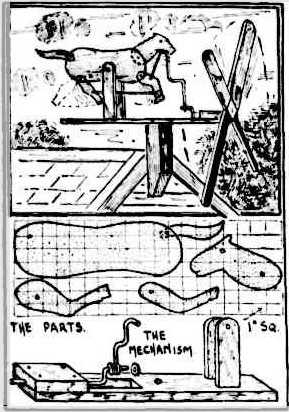 A Weather Vane
A Weather Vane
The sketch shows a novel weathervane, consisting of a horse which gallops along steadily so long as the propeller in front is turning. The mechanism is mounted on a board, pivoted at the centre, so that it can swing freely in the wind. In the sketch the baseboard is 24in. by 6in.,and 5-Bin. thick, the propeller blades are 18in. long and 3in. wide, and the model is 18in. long, but these sizes may be altered without affecting the working of the vane. Two body pieces are cut out, and the front leg, hind leg, head, and tail are pivoted between them. These parts are connected with wire, as shown in the upper sketch, so that the up-and-down movement of the head causes the legs to move backwards and forwards. Details of the simple crank arrangement, which operates the model, and the two uprights which form the model support, are shown in the lower sketch. These cranks are bent from thick wire, the front end of the main crank being fixed firmly in the centre of the propeller. The body of the model is fixed securely at the top of the uprights, and care must be taken to see that all the parts move freely. A Weather Vane. (1935, January 10). The Queenslander(Brisbane, Qld. : 1866 - 1939), p. 42. Retrieved fromhttp://nla.gov.au/nla.news-article27504430
Famous Weathervanes
NORWEGIAN SAILORS'CHURCH
The Norwegian Church of St. Olav, Rotherhithe, in London, is a seaman's place of worship, erected for seamen, and largely by them, an imposing structure that cost £40, 000 to erect. It has a richly gilt weather vane representing an ancient Viking ship crowning the spire. This weather vane is a landmark visible from afar, and easily discernible by Norwegian sailors at the docks. As usual with all Scandinavian seamen's churches, a large model sailing ship is suspended from the ceiling inside the building. Outside the church is a Norwegian granite memorial erected by the shipowners of Norway to the '8100 merchant seamen of that' country who lost their lives in submarine attacks on their ships during the war. It was unveiled by the Crown Prince Olav of Norway in June, 1927. NORWEGIAN SAILORS' CHURCH. (1929, December 15).Sunday Mail (Brisbane) (Qld. : 1926 - 1954), p. 13. Retrieved from http://nla.gov.au/nla.news-article97660565
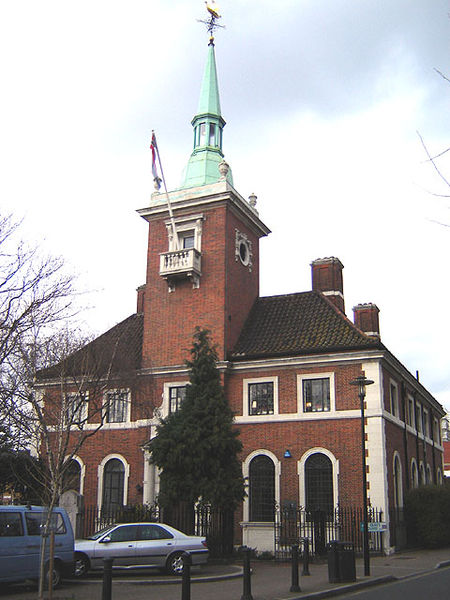 The Norwegian Church Abroad or The Norwegian Seamen’s Church (Norwegian: Sjømannskirken) is a religious organisation serving Norwegians and other Scandinavians travelling abroad. Founded in 1864, The Norwegian Seamen’s Mission – Sjømannsmisjonen – was established to secure the moral and religious education of Scandinavian seafarers, but also to give them a "breathing room" where a fellow countryman was available to lend an ear and give some attention. Today, the churches and their staff together with travelling pastors around the globe represent a "resource center" for all Norwegians travelling internationally.
The Norwegian Church Abroad or The Norwegian Seamen’s Church (Norwegian: Sjømannskirken) is a religious organisation serving Norwegians and other Scandinavians travelling abroad. Founded in 1864, The Norwegian Seamen’s Mission – Sjømannsmisjonen – was established to secure the moral and religious education of Scandinavian seafarers, but also to give them a "breathing room" where a fellow countryman was available to lend an ear and give some attention. Today, the churches and their staff together with travelling pastors around the globe represent a "resource center" for all Norwegians travelling internationally.
Right: St Olav's Church, Rotherhithe, Southwark, London. 11 February 2006. Photographer: Fin Fahey. Weathervane is a Viking longboat.
Sjømannskirken annually serves around 700 thousand Norwegians through over 30 churches and 16 mobile services in 30 countries around the world. Several churches operate on a Scandinavian basis. The Norwegian Church Abroad, its main office in Bergen, is a charitable organization supported by the Church of Norway and the Norwegian Government. Sjømannskirken is also a member of the ICMA and the Council of Nordic Seamen's Missions.
For most Norwegians travelling abroad, Sjømannskirken is a nice place to rest: one can read newspapers from home, buy Norwegian food and speak to other Norwegians. Many Norwegians living permanently abroad use the seamen's churches instead of the local ones.
Norwegian Church Abroad. (2013, October 26). In Wikipedia, The Free Encyclopedia. Retrieved from http://en.wikipedia.org/w/index.php?title=Norwegian_Church_Abroad&oldid=578795324
The Tower of the Winds is an octagonal Pentelic marble clocktower in the Roman Agora in Athens that functioned as a horologion or "timepiece". The structure features a combination of sundials, a water clock, and a wind vane. It was supposedly built by Andronicus of Cyrrhus around 50 BC, but according to other sources, might have been constructed in the 2nd century BC before the rest of the forum. The 12-metre-tall structure has a diameter of about 8 metres and was topped in antiquity by a weathervane-like Triton that indicated the wind direction. Below the frieze depicting the eight wind deities — Boreas (N), Kaikias (NE), Eurus (SE), Apeliotes (E), Notus (S), Livas (SW),Zephyrus (W), and Skiron (NW) — there are eight sundials. In its interior, there was a water clock (or clepsydra), driven by water coming down from the Acropolis. Recent research has shown that the considerable height of the tower was motivated by the intention to place the sundials and the wind-vane at a visible height on the Agora, making it effectively an early example of a clocktower. According to the testimony of Vitruvius and Varro, Andronicus of Cyrrhus designed the structure. The tower's columns bore capitals of a design now known as "Tower of the Winds Corinthian," although they lack the volutes ordinarily found in Corinthian capitals.
In early Christian times, the building was used as the bell-tower of a Byzantine Church. Under Ottoman rule it became a tekke and was used bywhirling dervishes. At that time it was buried up to half its height, and traces of this can be observed in the interior, where Turkish inscriptions may be found on the walls. It was fully excavated in the 19th century by the Archaeological Society of Athens.
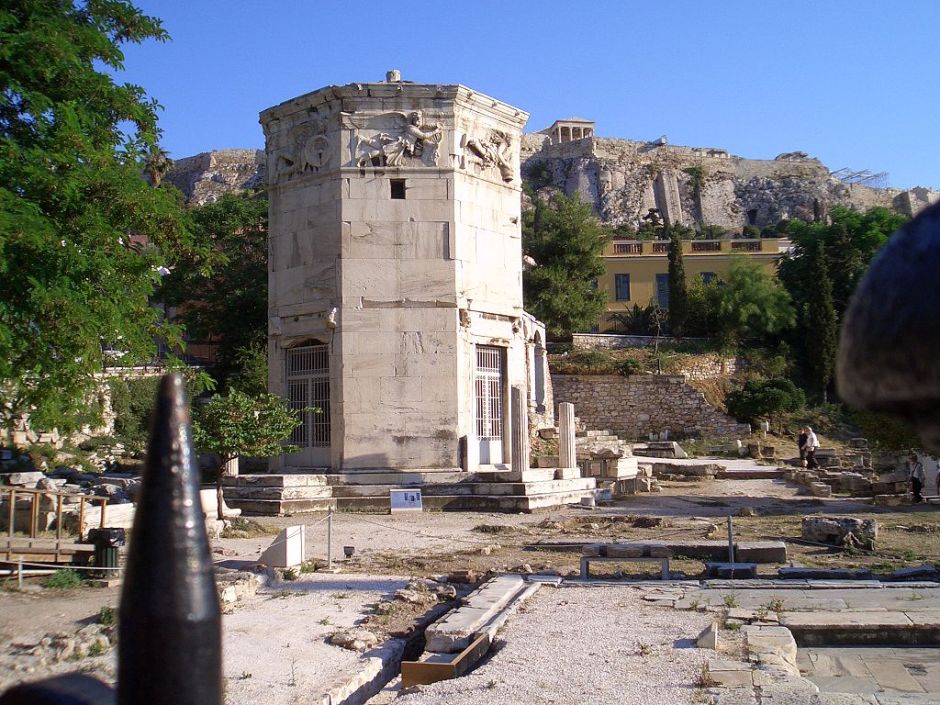
Tower of the Winds, Athens photo by Georg Zumstrull
Tower of the Winds. (2013, December 2). In Wikipedia, The Free Encyclopedia. Retrieved from http://en.wikipedia.org/w/index.php?title=Tower_of_the_Winds&oldid=584200533
An anemometer is a device used for measuring wind speed, and is a common weather station instrument. The term is derived from the Greek word anemos, meaning wind, and is used to describe any airspeed measurement instrument used in meteorology or aerodynamics. The first known description of an anemometer was given by Leon Battista Alberti around 1450. The anemometer has changed little since its development in the 15th century. Leon Battista Alberti is said to have invented the first mechanical anemometer around 1450. In following centuries, numerous others, including Robert Hooke and the Mayans, developed their own versions, with some being mistakenly credited as the inventor. In 1846, John Thomas Romney Robinson improved upon the design by using four hemispherical cups and mechanical wheels. Later, in 1926, John Patterson developed a three cup anemometer, which was improved by Brevoort and Joiner in 1935. In 1991, Derek Weston added the ability to detect wind direction. Most recently, in 1994, Dr. Andrews Pflitsch developed the sonic anemometer.
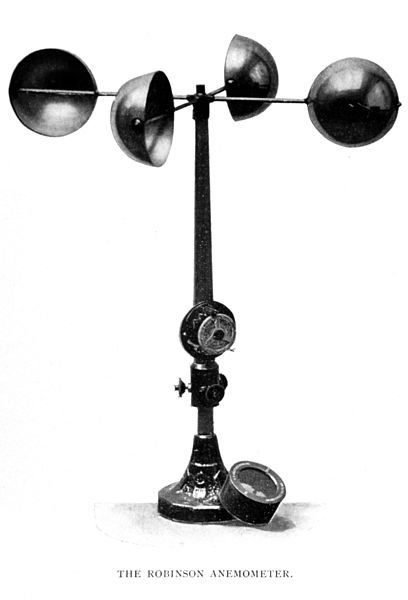
A hemispherical cup anemometer of the type invented in 1846 by John Thomas Romney Robinson from The Aims and Methods of Meteorological Work by Cleveland Abbe, in Maryland Weather Service, Johns Hopkins Press, Baltimore, 1899. Volume I, page 316.
Anemometer. (2013, November 5). In Wikipedia, The Free Encyclopedia. Retrieved from http://en.wikipedia.org/w/index.php?title=Anemometer&oldid=580342097
ANEMOMETER (from Gr. ἄνεμος, wind, and μέτρον, a measure), an instrument for measuring either the velocity or the pressure of the wind. Anemometers may be divided into two classes, (1) those that measure the velocity, (2) those that measure the pressure of the wind, but inasmuch as there is a close connexion between the pressure and the velocity, a suitable anemometer of either class will give information about both these quantities.
Velocity anemometers may again be subdivided into two classes, (1) those which do not require a wind vane or weathercock, (2) those which do. The Robinson anemometer, invented (1846) by Dr. Thomas Romney Robinson, of Armagh Observatory, is the best-known and most generally used instrument, and belongs to the first of these. It consists of four hemispherical cups, mounted one on each end of a pair of horizontal arms, which lie at right angles to each other and form a cross. A vertical axis round which the cups turn passes through the centre of the cross; a train of wheel-work counts up the number of turns which this axis makes, and from the number of turns made in any given time the velocity of the wind during that time is calculated. The cups are placed symmetrically on the end of the arms, and it is easy to see that the wind always has the hollow of one cup presented to it; the back of the cup on the opposite end of the cross also faces the wind, but the pressure on it is naturally less, and hence a continual rotation is produced; each cup in turn as it comes round providing the necessary force. The two great merits of this anemometer are its simplicity and the absence of a wind vane; on the other hand it is not well adapted to leaving a record on paper of the actual velocity at any definite instant, and hence it leaves a short but violent gust unrecorded. Unfortunately, when Dr. Robinson first designed his anemometer, he stated that no matter what the size of the cups or the length of the arms, the cups always moved with one-third of the velocity of the wind. This result was apparently confirmed by some independent experiments, but it is very far from the truth, for it is now known that the actual ratio, or factor as it is commonly called, of the velocity of the wind to that of the cups depends very largely on the dimensions of the cups and arms, and may have almost any value between two and a little over three. The result has been that wind velocities published in many official publications have often been in error by nearly 50%.
The other forms of velocity anemometer may be described as belonging to the windmill type. In the Robinson anemometer the axis of rotation is vertical, but with this subdivision the axis of rotation must be parallel to the direction of the wind and therefore horizontal. Furthermore, since the wind varies in direction and the axis has to follow its changes, a wind vane or some other contrivance to fulfil the same purpose must be employed. This type of instrument is very little used in England, but seems to be more in favour in France. In cases where the direction of the air motion is always the same, as in the ventilating shafts of mines and buildings for instance, these anemometers, known, however, as air meters, are employed, and give most satisfactory results.
Anemometers which measure the pressure may be divided into the plate and tube classes, but the former term must be taken as including a good many miscellaneous forms. The simplest type of this form consists of a flat plate, which is usually square or circular, while a wind vane keeps this exposed normally to the wind, and the pressure of the wind on its face is balanced by a spring. The distortion of the spring determines the actual force which the wind is exerting on the plate, and this is either read off on a suitable gauge, or leaves a record in the ordinary way by means of a pen writing on a sheet of paper moved by clockwork. Instruments of this kind have been in use for a long series of years, and have recorded pressures up to and even exceeding 60 lb per sq. ft., but it is now fairly certain that these high values are erroneous, and due, not to the wind, but to faulty design of the anemometer.
The fact is that the wind is continually varying in force, and while the ordinary pressure plate is admirably adapted for measuring the force of a steady and uniform wind, it is entirely unsuitable for following the rapid fluctuations of the natural wind. To make matters worse, the pen which records the motion of the plate is often connected with it by an extensive system of chains and levers. A violent gust strikes the plate, which is driven back and carried by its own momentum far past the position in which a steady wind of the same force would place it; by the time the motion has reached the pen it has been greatly exaggerated by the springiness of the connexion, and not only is the plate itself driven too far back, but also its position is wrongly recorded by the pen; the combined errors act the same way, and more than double the real maximum pressure may be indicated on the chart.
A modification of the ordinary pressure-plate has recently been designed. In this arrangement a catch is provided so that the plate being once driven back by the wind cannot return until released by hand; but the catch does not prevent the plate being driven back farther by a gust stronger than the last one that moved it. Examples of these plates are erected on the west coast of England, where in the winter fierce gales often occur; a pressure of 30 lb per sq. ft. has not been shown by them, and instances exceeding 20 lb are extremely rare.
Many other modifications have been used and suggested. Probably a sphere would prove most useful for a pressure anemometer, since owing to its symmetrical shape it would not require a weathercock. A small light sphere hanging from the end of 30 or 40 ft. of fine sewing cotton has been employed to measure the wind velocity passing over a kite, the tension of the cotton being recorded, and this plan has given satisfactory results.
Lind's anemometer, which consists simply of a U tube containing liquid with one end bent into a horizontal direction to face the wind, is perhaps the original form from which the tube class of instrument has sprung. If the wind blows into the mouth of a tube it causes an increase of pressure inside and also of course an equal increase in all closed vessels with which the mouth is in airtight communication. If it blows horizontally over the open end of a vertical tube it causes a decrease of pressure, but this fact is not of any practical use in anemometry, because the magnitude of the decrease depends on the wind striking the tube exactly at right angles to its axis, the most trifling departure from the true direction causing great variations in the magnitude. The pressure tube anemometer (fig. 1) utilizes the increased pressure in the open mouth of a straight tube facing the wind, and the decrease [v.02 p.0003]of pressure caused inside when the wind blows over a ring of small holes drilled through the metal of a vertical tube which is closed at the upper end. The pressure differences on which the action depends are very small, and special means are required to register them, but in the ordinary form of recording anemometer (fig. 2), any wind capable of turning the vane which keeps the mouth of the tube facing the wind is capable of registration.
The great advantage of the tube anemometer lies in the fact that the exposed part can be mounted on a high pole, and requires no oiling or attention for years; and the registering part can be placed in any convenient position, no matter how far from the external part. Two connecting tubes are required. It might appear at first sight as though one connexion would serve, but the differences in pressure on which these instruments depend are so minute, that the pressure of the air in the room where the recording part is placed has to be considered. Thus if the instrument depends on the pressure or suction effect alone, and this pressure or suction is measured against the air pressure in an ordinary room, in which the doors and windows are carefully closed and a newspaper is then burnt up the chimney, an effect may be produced equal to a wind of 10 m. an hour; and the opening of a window in rough weather, or the opening of a door, may entirely alter the registration.
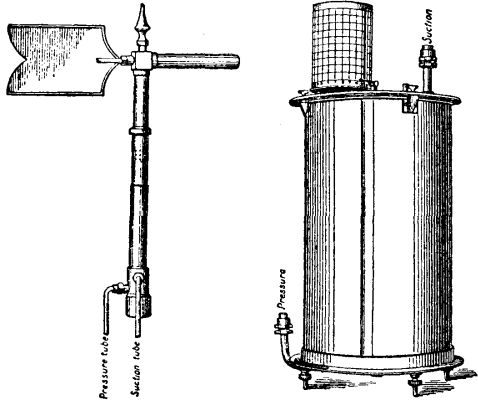
FIG. 1 & FIG. 2 Anemometers.
The connexion between the velocity and the pressure of the wind is one that is not yet known with absolute certainty. Many text-books on engineering give the relation P=.005 v2 when P is the pressure in lb per sq. ft. and v the velocity in miles per hour. The history of this untrue relation is curious. It was given about the end of the 18th century as based on some experiments, but with a footnote stating that little reliance could be placed on it. The statement without the qualifying note was copied from book to book, and at last received general acceptance. There is no doubt that under average conditions of atmospheric density, the .005 should be replaced by .003, for many independent authorities using different methods have found values very close to this last figure. It is probable that the wind pressure is not strictly proportional to the extent of the surface exposed. Pressure plates are generally of moderate size, from a half or quarter of a sq. ft. up to two or three sq. ft., are round or square, and for these sizes, and shapes, and of course for a flat surface, the relation P=.003 v2 is fairly correct.
In the tube anemometer also it is really the pressure that is measured, although the scale is usually graduated as a velocity scale. In cases where the density of the air is not of average value, as on a high mountain, or with an exceptionally low barometer for example, an allowance must be made. Approximately 1½% should be added to the velocity recorded by a tube anemometer for each 1000 ft. that it stands above sea-level.
(W. H. Di.)
From THE ENCYCLOPÆDIA BRITANNICA, A DICTIONARY OF ARTS, SCIENCES, LITERATURE AND GENERAL INFORMATION. ELEVENTH EDITION. VOLUME II. ANDROS to AUSTRIA. [E-Text Edition of Volume II - Part 01 of 16 - ANDROS to ANISE]. New York 1910-1911. Retrieved from: http://www.gutenberg.org/files/13600/13600-h/13600-h.htm
Researched and compiled by A J Guesdon, 2014.